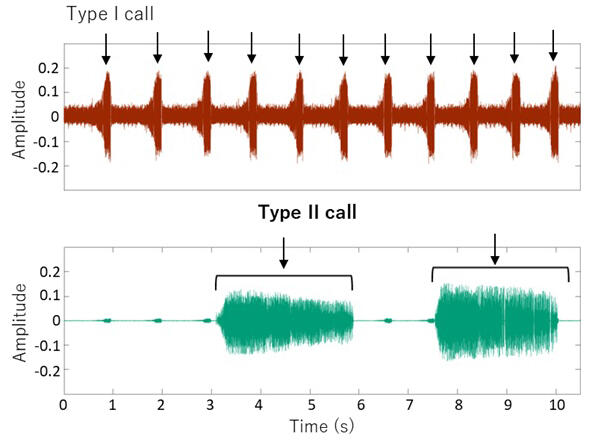Male "Tsutsukuboushi" cicadas produce two distinct types of loud calls. The first is a rhythmic call known as a "Type I call," transcribed in Japanese as "Ooshin-tsukutsuku, Ooshin-tsukutsuku." The second is a longer call known as a "Type II call" that can be written as "Juuu." It has been known that when two males are placed near each other, one will produce a type II call in response to the other's type I, but the timing of this response was not previously understood.
A research group consisting of Graduate Student Takahiro Ishimaru (at the time of the research) in the Graduate School of Systems and Information Engineering, and Associate Professor Ikkyu Aihara from the Institute of Systems and Information Engineering at the University of Tsukuba, has newly discovered a regularity in the timing difference of cicada calls. They found that when two male cicadas are placed near each other, one emits a type II call immediately after the other produces a type I call. Their findings were published in the Journal of Experimental Biology.

Provided by the University of Tsukuba
In their study, the researchers repeatedly conducted experiments in 2019-2020 where they placed two male cicadas 150 centimeters apart indoors and recorded their calls. As a result, they successfully measured the calls of 23 pairs, of which 19 pairs (83%) were confirmed to produce combinations of type I calls and type II calls.
Next, to investigate the regularity of the timing of the type II calls, they performed an analysis using phase differences. The phase difference is a quantity between 0 and 2π that is calculated by correcting the time difference between the two cicadas' calls by the call interval of one cicada. If the phase difference is close to 0 or 2π, it indicates that the two cicadas are calling almost simultaneously, while if it is close to π, it indicates that they are calling alternately at equal intervals. By analyzing the timing regularity of the two cicadas' calls in the recorded sounds, the researchers found that of the 23 cicadas that stably produced type II calls, 22 (96%) showed a concentration of phase difference distributions at specific values, indicating that they were calling with regularity. The average phase difference of these 22 cicadas was 0.46π, showing a bias toward immediately after the partner produced a type I call.
Furthermore, the researchers hypothesized that "'Tsutsukuboushi' cicadas produce type II calls to interfere with their partner's calls more efficiently than if they were to call randomly." They tested the validity of this hypothesis for each individual by combining experimental data with numerical simulations.
Journal Information
Publication: Journal of Experimental Biology
Title: Temporal structure of two call types produced by competing male cicadas
DOI: 10.1242/jeb.249399
This article has been translated by JST with permission from The Science News Ltd. (https://sci-news.co.jp/). Unauthorized reproduction of the article and photographs is prohibited.




